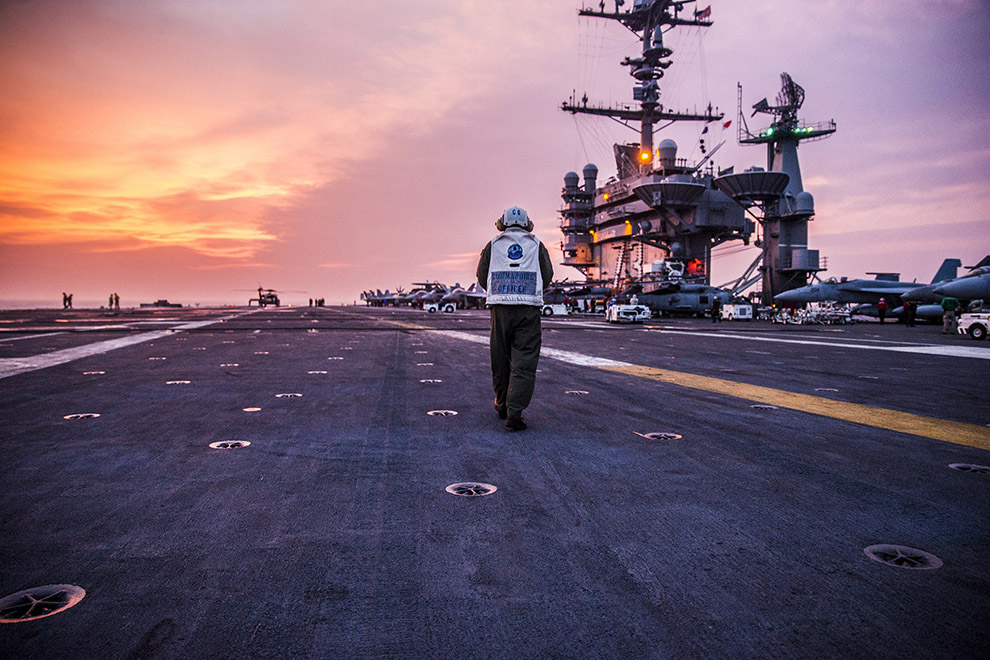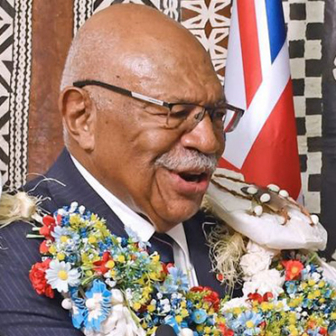Contest of the Century: The New Era of Competition with China
By Geoff Dyer | Allen Lane | $39.99
Asia’s Cauldron: The South China Sea and the End of a Stable Pacific
By Robert D. Kaplan | Random House | $32.99
Dangerous Allies
By Malcolm Fraser with Cain Roberts | Melbourne University Press | $49.99
Asia’s security system is suffering shakes and shocks and shivers. The tremors are frequent and the pressure keeps building. Consider some of the geostrategic quakes:
Tremor: The American president goes to Japan to announce that America is prepared to fight a war with China in the East China Sea. The contested Senkaku/Diaoyu islands may be occupied only by goats, but Barack Obama says they are covered by the war-fighting provisions of the US alliance. Japan says it has scrambled jets 700 times in the last two years to respond to Chinese flights near the islands.
Shake: After seventy years, Japan has returned as a defence and security player in Asia. Japan’s prime minister, Shinzo Abe, comes to Australia’s parliament to deliver another version of his “We’re back!” speech.
Shiver: The Chinese president, Xi Jinping, tells an audience in Shanghai that it’s time for Asia to rule itself: “It’s for the people of Asia to run the affairs of Asia, solve the problems of Asia and uphold the security of Asia.” The message is about American departure and Chinese leadership.
Shock: China moves a $1 billion oil rig inside Vietnam’s 200-mile exclusive economic zone, although the rig is only thirty kilometres from the Paracel islands it seized from South Vietnam in 1974. The confrontation at sea sparks anti-Chinese riots in Vietnam; four Chinese workers are killed and foreign factories burned.
These tremors cause Australia’s defence minister, David Johnston, to worry that Asia’s security situation is potentially “dire,” even “catastrophic.” Foreign minister Julie Bishop laments “unilateral or coercive behaviour” that risks miscalculation, misjudgement and escalating tensions, and draws a parallel between 1914 and 2014: “The most critical lesson from WWI is relevant – that isolated, single, random events can unleash forces that quickly spiral out of control.”
All these shakes produced a unique Australian response – the emergence of our first isolationist or non-aligned (and admittedly retired) prime minister. Malcolm Fraser steps up to argue it’s time for Australia to cut free from its addiction to great and powerful friends. Fraser thinks that, as allies, the United States and Japan are more of a threat to Australia than any danger posed by China.
The tremors foretell earthquakes because China is bumping against its neighbours like a huge tectonic plate, moving moods, markets and military spending. Some of the shocks China produces are almost inadvertent. So new are its new powers that part of its tectonic impact is covered by the Big Gorilla clauses in the Law of Unintended Consequences: (i) the Big Gorilla sits anywhere it wants to sit; (ii) the Big Gorilla may not notice if it sits on somebody else.
Even when China makes conscious choices affecting its neighbours, Beijing doesn’t always perceive the magnitude of the shock it delivers. What China sees as merely reaching for its expanding prerogatives can translate into a major shove – and the effect of recent shoves has been to send much of Asia rushing closer to the United States as the traditional protector.
China no longer follows the timid foreign policy bequeathed by Deng Xiaoping – “hide the brightness and nourish obscurity.” In place of the “hide and bide” approach that brought so much comfort to Asia for two decades, China is ready to “talk and take” or “show and tell” – and the fear is that Beijing is shifting towards “bash and bully.”
The uncertainties generated by China’s new power create just as many questions for the United States. According to the Financial Times correspondent Geoff Dyer, the new age of US–China rivalry will be the single most important factor in world politics for decades. “If globalisation has been the driving force over the last few decades – in fact, since China embarked on its economic reforms in the late 1970s, after the death of Mao – then there is now a powerful force pulling in the opposite direction,” he writes, “an old-fashioned struggle for influence and power between China and the United States, the two most important nations in the world.”
Geopolitical rivalry is back – no ideology at stake, just power and wealth. Dyer’s book calls this the contest of the century, and offers three propositions:
1. China is making the crucial shift from a government that accepts the international system to one that seeks “to shape the world according to its own national interests, from rule taker to rule maker. Beijing is starting to channel its own inner great power.” Dyer says China should not be demonised as “an anti-democratic hegemon launching a new Cold War.” Nor should it be romanticised as a “post-modern, Confucian meritocracy.” China is merely behaving as states do when they become very powerful.
2. China is “inevitably” entering a geopolitical competition with the United States, the nation that fashioned the existing order. The contest will range from control of the oceans in Asia to which currency will be used in international business. “Almost every important global issue will find itself coloured by this rivalry. Yet it will not be the win-at-all-costs ideological struggle of the Cold War. Instead, this will be an older, more fluid form of rivalry that is based on balance of power and building coalitions of support.”
3. The United States is in a strong position to deflect the Chinese challenge. If it can “clean its own financial house and avoid the temptations of either confrontation or isolation, it will still hold many of the best cards in the twenty-first century.”
Dyer offers the twin perspectives of a correspondent who was based in Shanghai and Beijing and an observer now writing from Washington. Where the last few decades saw many books on the rise of China, Dyer’s effort is part of a new genre looking at what China is doing now it has arrived. Two dates join to mark this arrival – 2008, when the United States crashed into the Great Recession that sits beside the Great Depression, and 2010, when China passed Japan to become the world’s second-largest economy.
China rushes to overtake the United States as the biggest economy and claim top-dog status, yet the transfer of influence and power is not as simple to track as GDP figures. Mapping this great contest, Dyer ranges across the shifting power balance in Asia and the choices confronting the US military, the brittle nationalism making China more assertive (“a nationalism that is tinged with a sense of victimhood”) and China’s challenge to the American dollar as the global currency in the era of post-American globalisation.
Dyer nominates Australia for an important role as the regional “weather vane.” For three decades, he says, Australia’s response to China’s rise has been “a sort of early-warning centre for the opportunities and risks. If you want to find out how the world will react to a more powerful China, Australia is a good place to start.” Does prosperity trump politics? Must you bend to Beijing if you depend on China’s economic dynamism? If Asia is to accept China’s leadership, Dyer writes, look for Australia shifting to the middle ground: “One of the early signs would be a decision by Australia to drift gradually away from its close defence relationship with the United States.”
The Asian backlash against Chinese bullying in the South China Sea in the last five years has rapidly created what Dyer calls “a perfect storm of modern geopolitics.” This storm makes the South China Sea “Asia’s cauldron,” according to the American journalist Robert D. Kaplan, symbolising the end of a stable Pacific and driving military rivalry between the United States and China. One big military effect is clear: the United States and China now see each other as the default enemy, the foe shaping their military plans for future conflicts in Asia.
Kaplan is a fine reporter who offers the politics and power of the contest flavoured by vivid travel writing and spiced by history. He starts with the idea that Europe is a landscape while East Asia is a seascape, which means that while last century’s contest was over land, in the Asian century the contested military spaces will be at sea (and in the air and outer space and the cyber domain). Imperial Germany before the first world war was primarily a land power because of Europe’s geography, Kaplan writes, while “China will be primarily a naval power, owing to the geography of East Asia.”
With that frame, Kaplan sees the South China Sea as Asia’s version of the Mediterranean, functioning as “the throat of the Western Pacific and Indian oceans” where sea routes coalesce in the Malacca, Sunda, Lombok and Makassar straits. Through that throat passes nearly 60 per cent of Japan’s and Taiwan’s energy supplies and 80 per cent of China’s crude oil imports.
The struggle in the South China Sea is not yet about traffic – it is about territory. Conflicting claims drive a scramble to grab any reef that can be used to buttress sovereignty. By Kaplan’s count, China has confiscated twelve geographical features, Taiwan one, Vietnam twenty-one, Malaysia five and the Philippines nine.
China wants the same thing that the United States sought in the Caribbean in the nineteenth century – the right to dominate its sphere. Kaplan predicts the South China Sea will become “the most contested body of water in the world,” with the United States, the reigning naval power, facing China’s dramatic expansion to become “the world’s second most powerful naval service.”
“The United States keeps China honest: limiting China’s aggression mainly to its maps, so that China’s diplomats and navy act within reason,” Kaplan writes. “That is not to say that the US is pure in its actions and China automatically the villain. For example, the US conducts classified reconnaissance activities on a regular basis against China in the Western Pacific that it would have difficulty tolerating were they directed at its own nearby waters by a rival great power. What the US provides to the nations of the South China Sea region is less the fact of its democratic virtue than the fact of its raw power, which counters that of China.”
If the balance of power can hold, despite the tremors, then the nations of Southeast Asia can retain their freedom, including the freedom to play off China and the United States against each other.
The body of Kaplan’s book is a description of the diverse contestants and claimants in this intricate Asian dance: China seeking to make the South China Sea both shield and strategic hinterland stretching to Indonesia; Vietnam as the principal protagonist, asserting sovereignty over the Paracel and Spratly islands, repeating the struggle against China at the core of Vietnamese history; Malaysia, both Islamic and “America’s most reliable – albeit quietest – ally around the South China Sea” apart from Singapore; the tough pragmatism of Lee Kuan Yew – “the good autocrat” – and Singapore’s quest for a military much stronger than its size; the prickly nationalism of the Philippines confronting China with a desperate return to US military patronage; the stubborn, inconvenient democracy of Taiwan, seeking to buy time and play a weak hand, serving “as the bellwether for the political and military situation throughout the Western Pacific.”
The course and condition of the US–China rivalry will depend on the rest of Asia as much as on the two superpowers. It will be a deeply complicated contest, offering room for manoeuvre by middle powers. The sharp divisions of the cold war will not recur; every nation will want equally strong relations with the big rivals, to have some say in shaping perceptions and interests in both Beijing and Washington. As Kaplan argues, “the future – in military as well as economic terms – may be distinctly multipolar, with a country like Vietnam – or Malaysia, Australia or Singapore – playing off a host of powers against each other.”
This is the regional context for Malcolm Fraser’s striking attack on Australia’s “dangerous allies” and his call for Australia to no longer stand with the United States. If Geoff Dyer’s Australian weather vane is one that drifts gradually from the American alliance, Fraser wants to speed away.
For the first time in our 200 years as colony and Commonwealth, we have a former leader (the third-longest-serving Liberal prime minister after Menzies and Howard) who does not want to be allied. Fraser sees the alliance as the real threat, with Australia “caught in a vice” as a “strategic captive,” now “more heavily aligned with the United States than at any time in our history.”
Fraser rejects a lot of history. Australia should not have fought in Vietnam, Afghanistan or Iraq; it should consider leaving the Anglo intelligence club – the grouping we share with the United States, Britain, Canada and New Zealand – if one cost is spying on behalf of America; it should close the Pine Gap satellite intelligence base and eject the US marines from Darwin.
Fraser thinks differences in the values of the United States and Australia make our dependence “fraught.” The worst outcome is that Australia would have to join Washington in a war with China: “If America were to lose a war with China, in military terms at least, America could withdraw to the western hemisphere. We would remain here, geographically part of the Asia-Pacific, but also a defeated ally of a defeated superpower.”
While deeply sceptical of the United States, he fears that Japan’s growing assertiveness and militarism make it a dangerous new factor. Fraser judges that Japan started the latest escalation in the East China Sea and that China has the strongest claim to the Senkaku/Diaoyu islands, which he regards as war booty seized by Japan in 1895. Continuing the alliance will mean “increased pressure from the United States to establish a more formal and all-encompassing defence relationship with Japan; a relationship that would make it much harder, if not impossible, for us to avoid being involved in any conflict between China and Japan.”
By contrast, he has a benign view of Beijing. “For China to be a danger,” he writes, “China would have to act out of character, contrary to all the traditions of its past. If China were to be a danger, it would also signal a total failure of Australian diplomacy. China does not represent a threat to the integrity of an independent Australia.” This is not a line that would even qualify as risible in Hanoi or Manila, while for Australia it raises profound questions that Fraser deals with within three options:
1. Continue with the alliance and follow US decisions in foreign and security policy, continuing “our historic policy of strategic dependence on a great and powerful friend.” Being a US “surrogate” or “deputy sheriff” or “lackey,” Fraser writes, would hinder Australia’s relationships in East and Southeast Asia and “involve submerging our own identity, going along with American objectives, and being prepared to fight in America’s wars.”
2. Have it both ways by asserting independence while continuing the alliance. This is not possible, Fraser thinks, because Australia is so tightly enmeshed in America’s strategy. “We cannot avoid complicity in what America does by just saying that we are not involved and we are not going to add forces of our own,” he argues. He doubts that Australia has the “diplomatic and political prowess” to persuade Washington to accept limits on the US Marine Task Force in Darwin. Even harder would be trying to control the operation of the Pine Gap intelligence facility near Alice Springs, which he rates as “enormously important to America’s offensive capabilities.”
3. Seek strategic independence and step away from the United States to avoid being complicit in America’s future military operations and “being forced into a war that was not in our interest.” Close Pine Gap with five years’ notice and tell the Marine Task Force to leave Darwin. “I discount direct threats to Australia as a result of strategic independence. It is strategic dependence that provides the greatest problem to our future in the region. Indeed, the current interpretation of ANZUS by Australian leaders is paradoxical – it might be the biggest threat to our own security despite it being presented as the guarantor of our security.”
Fraser makes the case to kill the alliance but doesn’t take his argument fully to that conclusion. Even he can’t totally abandon the great and powerful protector. Instead, the penultimate paragraph of the book merely calls for a different and more equal relationship with the United States.
After all the preceding fire, this lame conclusion points to the great problem with Fraser’s provoking and passionate attack: he gives almost no detail of what this independent future would look like. He spends 275 pages on the history and effects of Australia’s alliance addiction, then nine pages on the alternative future that would face Australia “as a middle ranking power, standing on our own feet.”
Kicking against 200 years of history is a big job. And Malcolm Fraser is still enough of a politician to know that surveys consistently show more than three-quarters of Australians embrace the alliance. Attacking the alliance would be even tougher if Fraser were too explicit about the alternatives.
The future Malcolm Fraser is pointing to – but not discussing – leads to several different scenarios. Australia could line up with Asia’s other middle powers and seek to use this loose coalition to strike a shifting balance between the United States and China – and coming fast, India. (This is a version of Fraser’s second option with a bigger Asian flavour.) Or Australia could make a fundamental shift to armed neutrality. Or Australia could reach a new settlement with China that recognises Beijing’s prerogatives as Asia’s pre-eminent power.
To be clear, Fraser does not mention armed neutrality or a new alignment with China. He thinks Australia can stand clear of the big players: “Strategic independence would allow Australia to agree and disagree with both Washington and Beijing as it suits our interests.” It’s a simple solution – if it is that simple. The reader could offer armed neutrality or a shift into China’s orbit as answers to Fraser’s great question because his prescription is so sketchy. But Fraser’s book is valuable because it confronts Australia’s role in the contest of the century, even if the vision offered comes with few details.
In fact, Fraser stands with a lot of other thinkers and leaders in not being at all clear about how the contest will go. Where he is unusual is in wanting to yank free of those damned Yankees while the rest of Asia is rushing to lavish fresh love on them.
The traditionally non-aligned Asian powers Fraser wants to join are frantically leaning towards the United States. From India to Vietnam to Malaysia to Indonesia, everyone is seeking closer security ties with the Americans. Relying on the wisdom of crowds is not the usual way to make grand strategy, but the Fraser conclusion about how benign China is likely to be is distinctly different from that of Asian governments looking at the same trends.
The contest of the century is launched, but this will be more a nineteenth- than a twentieth-century struggle – a contest over power rather than ideology. Australia’s opt-out options are limited. More tremors ahead. •




